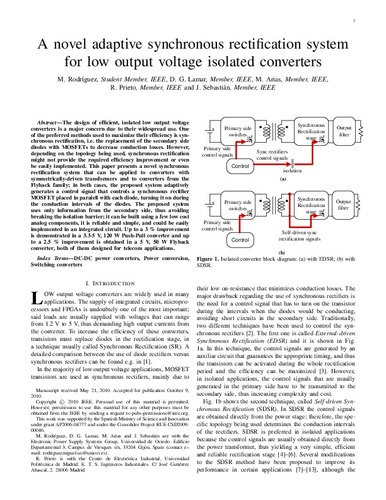A Novel Adaptive Synchronous Rectification System for Low Output Voltage Isolated Converters
Fecha de publicación:
Versión del editor:
Citación:
Descripción física:
Resumen:
The design of efficient isolated low output voltage converters is a major concern due to their widespread use. One of the preferred methods used to maximize their efficiency is synchronous rectification (SR), i.e., the replacement of the secondary side diodes with MOSFETs to decrease conduction losses. However, depending on the topology being used, SR might not provide the required efficiency improvement or even be easily implemented. This paper presents a novel SR system that can be applied to converters with symmetrically driven transformers and to converters from the flyback family; in both cases, the proposed system adaptively generates a control signal that controls a synchronous rectifier MOSFET placed in parallel with each diode, turning it on during the conduction intervals of the diodes. The proposed system uses only information from the secondary side, thus avoiding breaking the isolation barrier; it can be built using a few low-cost analog components, is reliable and simple, and could be easily implemented in an integrated circuit. Up to a 3% improvement is demonstrated in a 3.3-5-V 120-W push-pull converter, and up to a 2.5% improvement is obtained in a 5-V 50-W flyback converter, with both of them designed for telecom applications
The design of efficient isolated low output voltage converters is a major concern due to their widespread use. One of the preferred methods used to maximize their efficiency is synchronous rectification (SR), i.e., the replacement of the secondary side diodes with MOSFETs to decrease conduction losses. However, depending on the topology being used, SR might not provide the required efficiency improvement or even be easily implemented. This paper presents a novel SR system that can be applied to converters with symmetrically driven transformers and to converters from the flyback family; in both cases, the proposed system adaptively generates a control signal that controls a synchronous rectifier MOSFET placed in parallel with each diode, turning it on during the conduction intervals of the diodes. The proposed system uses only information from the secondary side, thus avoiding breaking the isolation barrier; it can be built using a few low-cost analog components, is reliable and simple, and could be easily implemented in an integrated circuit. Up to a 3% improvement is demonstrated in a 3.3-5-V 120-W push-pull converter, and up to a 2.5% improvement is obtained in a 5-V 50-W flyback converter, with both of them designed for telecom applications
ISSN:
Patrocinado por:
Trabajo apoyado por el Ministerio de Ciencia e Innovación (AP2006-04777 y Consolider RUE CSD2009-00046)
Colecciones
Ficheros en el ítem




